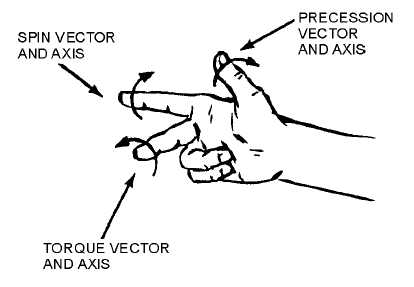3-11
Figure 3-10.—Right-hand rule for determining direction of precession.
This three-finger rule is useful for analyzing any gyroscope motion problem because if the directions
of any two of the three vectors are known, the direction of the third vector can be found and the motion
around this vector may be determined.
Q-9. What type of force acts ONLY through the center of gravity of a gyro, and does NOT cause
precession?
Q-10. The amount of precession that results from a given force is determined by what quantity?
Q-11. What factor determines the direction a gyro will precess in response to a particular force?
Q-12. When using the tight-hand rule to determine precession, which finger indicates the direction of
the applied force?
DEGREES OF FREEDOM
A gyro can have different degrees of freedom, depending on the number of gimbals in which it is
supported and the way the gimbals are arranged. Do not confuse the term "degrees of freedom" with an
angular value such as degrees of a circle. The term, as it applies to gyros, is an indication of the number of
axes about which the rotor is free to precess.
A gyro mounted in two gimbals has two degrees of freedom. When two gimbals are used, the gyro is
said to be UNIVERSALLY MOUNTED. This arrangement provides two axes about which the gyro can
precess. These two axes and the spin axis intersect at the center of gravity of the entire system (excluding
the support). Because of this arrangement, the force of gravity does not exert a torque to cause precession.
The rotor, inner gimbal, and outer gimbal are balanced about the three principal axes.
TWO DEGREES-OF-FREEDOM GYROS
The two-degrees-of-freedom (free) gyros can be divided into two groups. In the first group, the
gyro's spin axis is perpendicular to the surface of the Earth. Thus the gyro's rotor will spin in a horizontal

